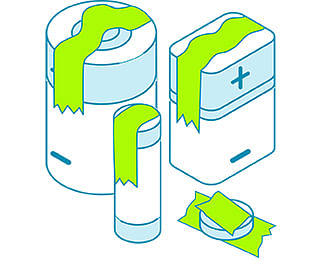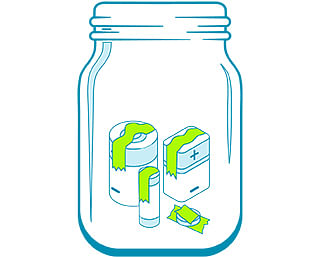Safe battery disposal
How to safely dispose of your household batteries.
Did you know that batteries are considered hazardous waste and should never be disposed of in your red-lid landfill or yellow-lid recycling bins?
Batteries can be a fire hazard if they are crushed or damaged and could spark to cause a fire in the back of the collections truck or at the Central Waste Facility landfill site near Wolumla.
90% of Australia’s old batteries end up in landfill, where they can leach toxic materials like mercury or lead into waterways and ecosystems. Batteries also contain valuable materials like magnesium and zinc, that can easily be recycled.
Here’s how to recycle them safely in 3 steps:
- Tape the terminals of your batteries – this prevents them sparking and creating a fire during transport and recycling

- Store batteries safely at home in a non-combustible, non-metal container (like glass) out of reach of children, for up to 6 months until you are ready to drop them off.

- Take batteries to one of the following dedicated recycle drop-off point for FREE:
- Community Recycling Stations - each of our Council libraries accept all AA, AAA, C, D, 9V and button batteries, and mobile phones and chargers.
- Community Recycling Centre at Merimbula Waste and Recycling Centre accepts all AA, AAA, C, D, 9V and button batteries, as well as car batteries, removable/rechargeable lithium-ion batteries like those found in cameras, power tools or other appliances, and automotive battery charging packs.
- B-cycle battery recycling bins can be found at all Woolworths, Big W, Mitre 10, Aldi and Total Tools stores in the Bega Valley, and they accept AA, AAA, C, D, 9V and button batteries. Some places also accept mobile phones and chargers, check before you drop them off.
What happens to your recycled batteries?
Once collected, the batteries are processed to recover plastics and metals that can be recycled into new batteries. Up to 95% of the materials in batteries can be recovered and reused, including plastics and metal (steel, aluminium and copper) in the casings. Components like cobalt, nickel and lithium are used to produce a mixed-metal dust which then is used to produce new lithium-ion batteries. Visit Envirostream for more information about the process.






Was this helpful?